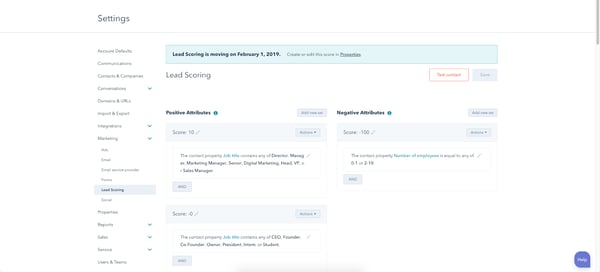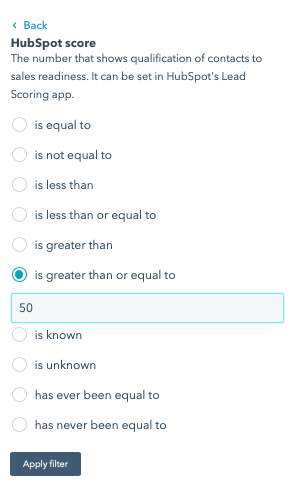Leads aren’t all made equal… I’m sure you’ve heard it before (from your sales team). However, this is correct.
Leads might enter your sales process at any point during the process. Some leads may appear to be ”hotter” or ”qualified” than others. To get to the finish of your sales process, these people only need a little help.
However, a lead will frequently enter your sales process and, despite the fact that they’ve given you their contact information and begun connecting with your brand, they’re unqualified.
The following could be the reason:
- They haven’t decided whether or not to buy your product or service yet.
- Your product or service is insufficiently tailored to their requirements.
- Perhaps the time required to convert them is excessive.
Having your sales team follow any of these leads will almost certainly cost you more money than you will receive in return. Isn’t there some way to separate the hot from the cold?
The answer is lead scoring.
So, don’t waste any more time on leads that will inevitably fail: Start filtering!
What is Lead Scoring?
Let’s make certain we’re all on the same page when it comes to lead scoring.
Lead scoring is a rule-based, customized approach for grading leads to determine whether they are cold, lukewarm, or red hot, providing your marketing and sales teams a better sense of where to spend their efforts. Remember that hotter leads are closer to converting, but colder prospects require additional lead nurturing or are currently unprepared/unqualified to make a purchase choice.
When determining their scores on a (usually) 0-to-100-point system, an automated lead scoring system considers not only their demographics (e.g., industry, job title, firm size, gender), but also their conduct. Visiting your company’s website, opening an email, and filling out an online form are all examples of behaviors. The difficult part is figuring out what rules you’ll need for your own model.
Why Does Lead Scoring Matter?
Why should you spend time in HubSpot scoring leads?
You must, however, be aware of which routes to pursue. To summarize, lead scoring may be used to construct HubSpot active lists.
Sort different sorts of contacts into distinct smart lists, such as MQLs vs. SQLs.
Finally, you can use these active lists to develop nurturing workflows that enroll the right audiences. For example:
- MQL active lists direct MQLs to be nurtured further before being forwarded to sales.
- To seal a deal, SQL active lists deliver SQLs and their behavioral and demographic data to sales.
Lead scoring increases revenue by discovering and converting your most qualified audiences who haven’t quite made it through your sales process.
Step 1: What Components Should My Lead Scoring Model Include?
These numbers may be arbitrary when you’re choosing lead score values to determine a lead’s quality; nonetheless, you’re the ultimate arbiter on how much impact each lead score set has on the outcome of a lead’s quality.
Let’s look at what factors go into determining the quality of a lead.
Implicit and explicit criteria
Understanding the difference between these two types of criteria can help you better understand your lead scoring system. Explicit scoring entails determining a lead’s qualification based on information provided directly by the lead — for example, information provided on a landing page form by a site visitor.
Implicit scoring, on the other hand, is based on a lead’s level of interest being inferred by tracking the action that leads to a sale. Both behavior and tracking are predominantly digital in today’s marketing environment; typical monitored actions include most frequented pages, emails opened, shared articles, and downloaded information.
You may begin to understand clearly what kind of leads your organization is aiming to focus on and which leads from the pool of candidates stand out by taking both implicit and explicit factors into account.
Tiered behavioral scoring
A lead automation model’s principal function is to attribute changing degrees of relevance to the actions that your leads take. The simplest method to start arranging your criteria is to make a comprehensive list of relevant lead behavior in several categories, such as the ones below:
- Your website
- Email campaigns
- Info forms
- Downloadable content
- In-person events
- Webinars
- Direct interaction with company representatives
The following stage is a little more difficult: you must rank the acts in each category in order of priority and apply appropriate point values to them. Is it as important to open an email as it is to click on a link in it? Is it as vital to visit your company’s home page as it is to approach your booth at a trade show? Take some time to consider your options in order to establish a more effective and accurate scoring system.
Demographic scoring
While a static and thus less complicated piece of your model, demographic lead qualifying is nevertheless important and should not be disregarded. Details such as the following are relevant demographic criteria:
- Location (state, region, country, etc.)
- Industry
- Position
- Company size and type
- Revenue
- Age
- Gender
It’s helpful to review your ideal buyer profile to understand the demographics of the person or business you’d consider a good fit when considering what impact a certain demographic attribute would have on the lead’s score.
Negative scoring
How can you tell what’s excellent from what’s terrible if there isn’t any?
In reality, distinguishing between qualified and unqualified leads will aid your team’s overall process. This reduces the amount of time you waste on leads who aren’t qualified. And, as you may be aware, squandered time equates to squandered funds.
Additionally, distinguishing unqualified from qualified leads might help your marketing and sales teams work together more effectively because they won’t be wasting their time.
This could indicate that a lead isn’t in your target demographic, or that they’re in the wrong industry or aren’t decision-makers in their companies.
This could imply that their actions indicate that they prefer not to contact with your business, such as transferring your firm’s emails to spam or inserting a personal email address into a form’s landing page rather than a company email address.
Side note: sales and marketing cooperation
Your marketing and sales teams’ objectives must be in sync. Otherwise, leads could get lost in the shuffle during the sales process. Their buyer’s journey may then take them somewhere else – to a direct competition!
To ensure that this procedure runs as smoothly as possible, you must first qualify a lead with lead scoring. Again, you don’t want to waste your sales team’s time by sending them ”fake” leads.
As a result, one move your organization can take is to include sales in the process of determining lead scoring values. They may have an objective viewpoint that isn’t perceived through the eyes of a marketer. Make use of it!
Step 2: How to Set Up Lead Scoring in HubSpot
Let’s get down to business and assign and create lead scoring values and attributes in your HubSpot account.
But initially, there are two different types of lead scoring: Manual Lead Scoring and Predictive Lead Scoring.
We’ll only cover Manual Lead Scoring here; however, Predictive Lead Scoring is useful if you’re a HubSpot Enterprise user because it uses learning algorithms and analysis of customer and industry sets to forecast the possibility of a lead closing within the next 90 days.
You can find your lead score tool in HubSpot under: Settings > Marketing > Lead Scoring.
You must select the following variables to create a new lead score set:
- Property type: This could simply be a contact property or company property.
- The property: This could be a default property or a custom property.
- Action: This is whatever action the property is following.
- The action’s variable: This could be the general action or specified outcome.
- Score: This is the positive, negative, or neutral value that you assign for the lead score set.
Let’s have a look at how to get started with manual lead scoring:

Add a new lead score set:
- Set Positive Attributes → Add New Set → Assign Score and Action
- Set Negative Attributes → Add New Set → Assign Score and Action
You can evaluate how a contact performs after you’ve set all of your lead scoring criteria. To do so, go to the top-right corner of the screen and select Test contact.
Step 3: Determine Lead Score Thresholds and Segment With Active Lists
Create active lists in HubSpot that use lead score thresholds if you want to apply lead score values to multiple contacts at once.
What I mean is that you can use arbitrary values in active lists to rank contacts who have joined them. On a scale of 0 to 100, for example:
- A visitor would be ranked 0.
- A prospect might be ranked 0 – 25.
- A MQL might be ranked 26 – 50.
- A SQL might be ranked 51 – 100.
You’re segmenting your database this way.
Follow these steps to establish your active list based on lead score criteria:
- Navigate to Contacts > Lists.
- In the upper-right, click Create list.
- Choose Contact properties as your filter type.
- Then, search HubSpot score and attribute it any signifier and number that’s appropriate for the audience you’d like to include in your lead nurturing workflow.
- If it’s a workflow targeting MQLs to convert them into SQLs, you may want to select is greater than or equal to and enter a relative-to-your-business, sales-qualifying score.

Furthermore, if you want to attribute more criteria to a lead score active list, you can. Again, to target MQLs to convert them into SQLs, select Contact properties and set it to the Lifecycle stage | is not a customer. Or, perhaps, you want to target a specific industry. You can set Company property | is equal to | Tool manufacturer or a relevant industry that your business would nurture.
Step 4: Assigning Lead-Scored Active Lists to Nurturing Workflows
Target your best qualified leads with your newly produced lead-scored active lists. We’ve already gone through a lot of the steps. Now it’s only a matter of putting the puzzle together.
So, let’s see…
….After you’ve assigned lead score sets and values,…
….After you’ve defined and created active list thresholds…
You’ll want to make sure that leads are assigned to the right workflows; otherwise, the path they take ahead may be incorrect for them, and you may lose a potential customer.
Once a lead has been scored, it must be actionable. It should be sensible and consistent with their previous behavior.
So, if a contact’s resulting score places them in:
- MQL active lists: Enroll them in further lead nurturing workflows to better qualify them before being sent to sales; or
- SQL active lists: Enroll them in sales-oriented workflows that familiarize them with your sales team (and vice-versa) and guide them towards the “closing” stage.
What Results Can I Expect?
You may recall the B2B tech brand PlanetTogether, with whom we assisted in increasing their inbound lead flow by 325 percent and reducing their sales cycle from 6 to 9 months to 3 months. They also categorized their consumers with lists and lead scoring to give their sales staff automatic lead notifications as part of a bigger strategy to boost their business. Their sales team was able to better handle more prospects with consultations and deliver faster response times as a result of this.
PlanetTogether’s total sales increased by 300 percent as a result of this. What a steady increase!
Don’t let the best leads slip through your fingers. By ensuring that your buyer’s journey is as frictionless as possible, you may use lead scoring to support your wider lead nurturing strategy.
So, get started with these steps:
- Clarify your campaign’s goal.
- Make sure you have a way to collect a visitor’s contact information.
- Have property values in place.
- Assign scores to leads.
- Create active lists.
- Enroll leads via active lists into targeted workflows.
Good luck, and don’t hesitate to contact us if you require any guidance on Lead Nurturing or any other related topic!
Originally published on HubSpot, Feb 4, 2019 9:00:00 AM, updated July 12 2019




